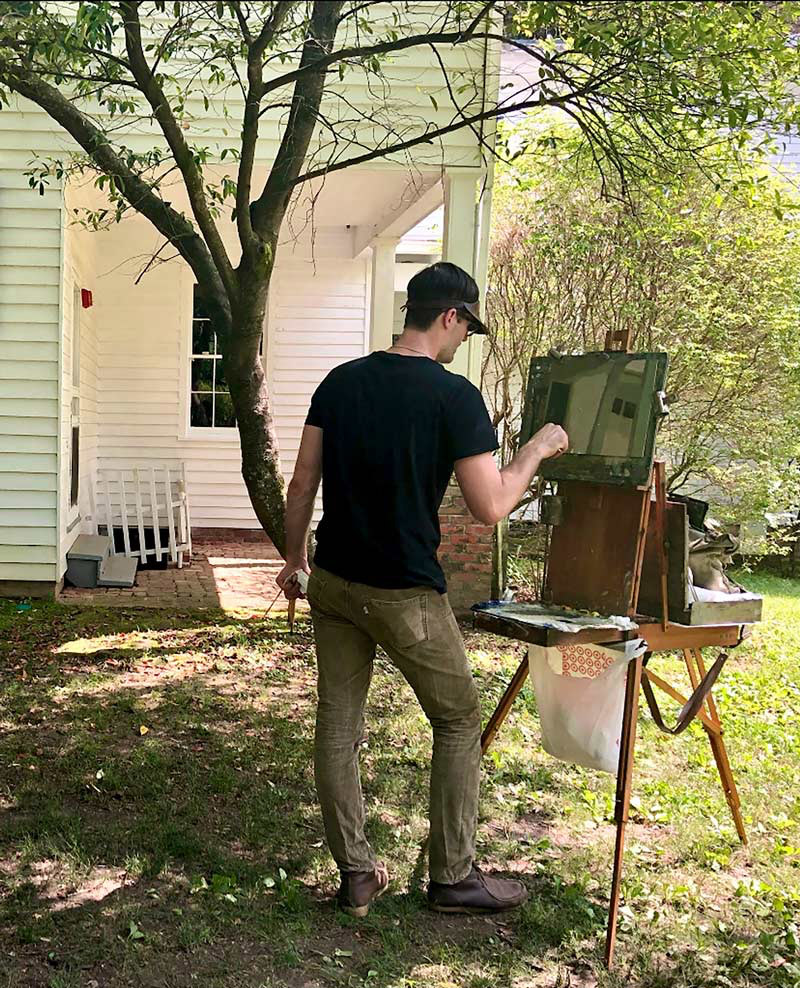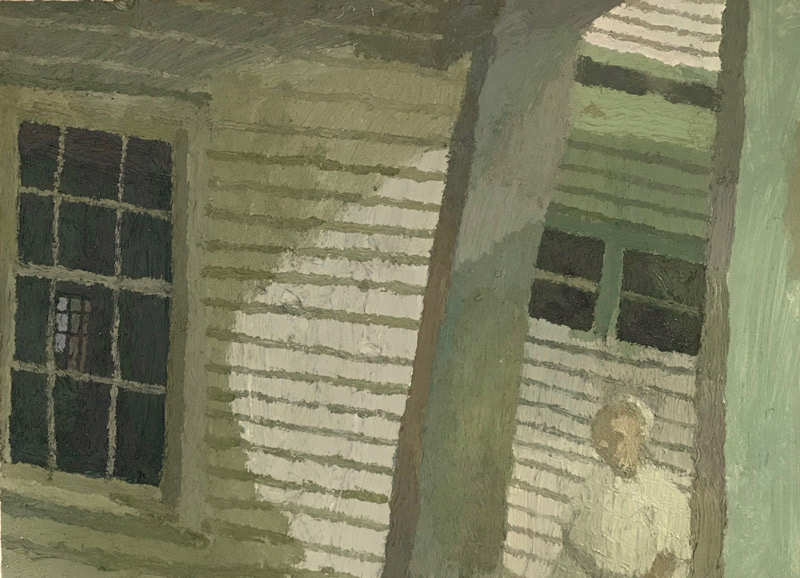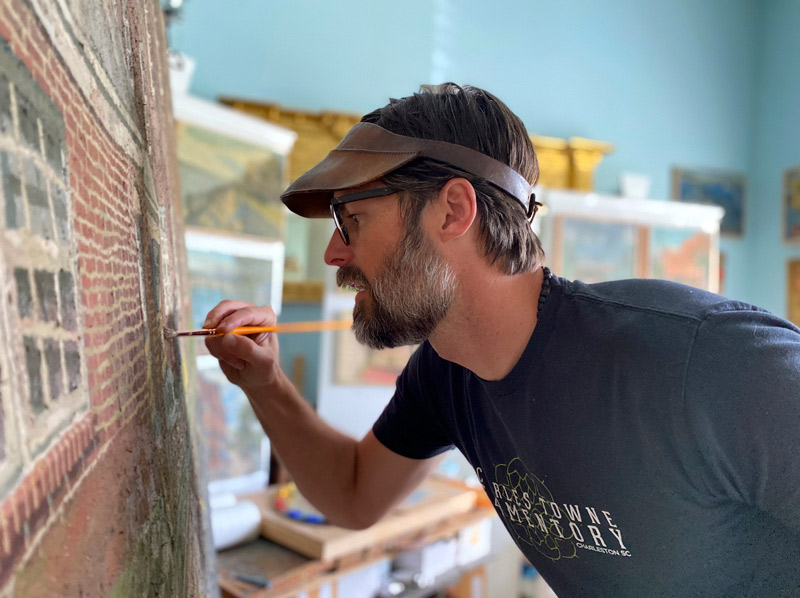Looking & Seeing
one long look at one work of art
John O'Hern is an arts writer, curator and retired museum director who is providing a weekly contemplation of a single work of art from our gallery. In our fast-paced lives overflowing with information, we find it necessary and satisfying to slow down and take time to look. We hope you enjoy this perspective from John.

John O'Hern has been a writer for the 5 magazines of International Artist Publishing for nearly 20 years. He retired from a 35-year-long career in museum management and curation which began at the Albright-Knox Art Gallery where he was in charge of publications and public relations and concluded at the Arnot Art Museum where he was executive director and curator. At the Arnot Art Museum he curated the groundbreaking biennial exhibitions Re-presenting Representation. John was chair of the Visual Artists Panel of the New York State Council on the Arts and has written essays for international galleries and museums.
August 30, 2024
BRIAN REGO | Faulkner's Cabin

The art world is a small one. Within it, the world of representational art is even smaller.
The painting I’ve chosen for this week’s ramble is Brian Rego’s Faulkner’s Cabin. As I watched his videos and looked at his art, I kept asking myself “How do I know this guy?” I decided to run a search of my Dropbox folders for “American Art Collector” and, lo and behold, in May 2014, I had written an article on Perceptual Painters, an artists collective that Brian had founded with a group of friends and fellow artists.
At the time, Brian told me the artists paint from nature and the model, relishing “the kind of energy that exists working directly from the motif. We don’t work from photographs. I think there is an exchange between the motif, the painting, and the painter that only occurs working from life. That’s one of our core sensibilities.” As he has grown in his art and observational skills, that remains a core sensibility.
 Back home, Brian painted Faulkner’s Cabin at Rowan Oak, William Faulkner’s home in Oxford, Mississippi. He has often shared workshop teaching duties with his close friend Philip R. Jackson, Associate Professor of Art and Painting Area Head at the University of Mississippi Oxford. One of their frequent subjects is Rowan Oak.
Back home, Brian painted Faulkner’s Cabin at Rowan Oak, William Faulkner’s home in Oxford, Mississippi. He has often shared workshop teaching duties with his close friend Philip R. Jackson, Associate Professor of Art and Painting Area Head at the University of Mississippi Oxford. One of their frequent subjects is Rowan Oak.
I had met Philip in 2005 when he was an art instructor at Columbus College of Art and Design in Ohio when I was there to give a lecture on contemporary representational art.
Faulkner acquired the run-down property in 1930 and named it Rowan Oak after two trees: the rowan or mountain ash tree of Scotland, a symbol of peace and security, and the live oak of America, a symbol of strength and solitude. He used the 1840s log cabin to house his milk cow and lawn tools.
When Brian was studying for his MFA at the Pennsylvania Academy of the Fine Arts (PAFA), he felt the kind of art he and his friends were interested in wasn’t supported strongly enough. He explains, “There was a small faction of us who were thriving and Scott Noel was an advocate for what we were interested in. He introduced me to painters I had not been aware of and provided a space for us to explore. He was like our guiding light in that environment.”
Scott, who began teaching at PAFA in 1980, also figures in Brian’s Rowan Oak experience. He suggests that passages in Faulkner’s novel The Sound and the Fury were very poetic and his “observations were so painterly”. One of my favorite passages is “I could smell the curves of the river beyond the dusk and I saw the last light supine and tranquil upon tideflats like pieces of broken mirror, then beyond them lights began in the pale clear air, trembling a little like butterflies hovering a long way off.”
 Another painting Brian produced at Rowan Oak is Faulkner's House, the writer’s 1840s Greek Revival home. There is a photo of Brian painting it on site—before the addition of a figure that you can see in the finished painting.
Another painting Brian produced at Rowan Oak is Faulkner's House, the writer’s 1840s Greek Revival home. There is a photo of Brian painting it on site—before the addition of a figure that you can see in the finished painting.
The composition of Faulkner’s Cabin is complex. I like paint and was immediately drawn to the painting because it appears that Brian built the cabin out of paint applied in thick impasto. The fence rails, emerging from the lower right of the composition are nailed onto the finished logs of the cabin, forming a line that continues off the edge of the panel on the left. There is more activity in the space to the right of the juncture of the cabins side and front walls.
The solid space of the cabin and the air around it aren’t static, he explains. “Space cannot be inanimate. It’s completely animated. Forms in space are constantly moving, concealing and revealing. The shape of the space is constantly changing.”
Always hung up on narrative, I asked him if the figure in the painting is Faulkner working in his garden. “The figures emerge from the subconscious,” he replied. “They’re compositional. I always ask, ‘Where does this figure need to exist?’ In this painting, I wanted to compress the scale of the cabin. The role of the figure is not to establish a narrative but I Iove to hear the narratives people bring to the paintings.”
 Brian’s orientation to nature is spiritual. “We sense a kinship with nature. It’s part of us and we’re part of it. On a physical level we come from it and we return to it. There’s beauty and unpredictability, order and disorder, reconstruction and reconstruction. There’s the intelligence of nature. There are visual phenomena and those that can be described by physics, and there is the metaphysical. I sense all that happening at once. It’s profound, both present and timeless. It’s the miracle of existing, the fact that it even exists and even seems to exist beyond itself.”
Brian’s orientation to nature is spiritual. “We sense a kinship with nature. It’s part of us and we’re part of it. On a physical level we come from it and we return to it. There’s beauty and unpredictability, order and disorder, reconstruction and reconstruction. There’s the intelligence of nature. There are visual phenomena and those that can be described by physics, and there is the metaphysical. I sense all that happening at once. It’s profound, both present and timeless. It’s the miracle of existing, the fact that it even exists and even seems to exist beyond itself.”
When I ran an architecture unit for the Western New York Institute for the Arts in Education for children from kindergarten through high school, I found fourth graders to be the most exciting. They had insights and the confidence to express them. A few years later, peer pressure and the constaints of culture discouraged their expression.
Brian has found the same situation working with students and observes, “It’s the rare older student who has that innocence.” In his own work, as he manipulates the physicality of the paint to express volume and space and to communicate symbolically something that exists beyond the observable subject, he maintains a sense of innocence and wonder, “going out into the landscape and finding something I didn’t anticipate."
View work by Brian Rego ►

